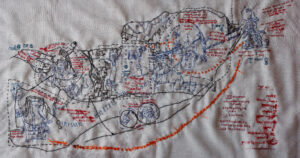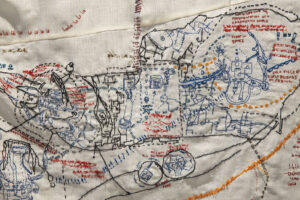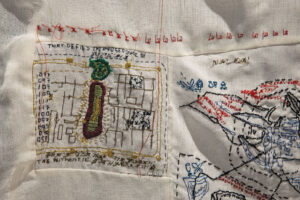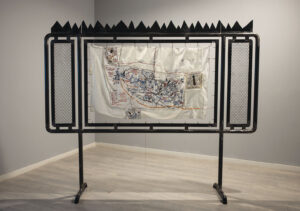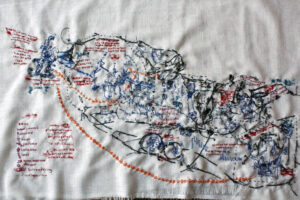Media Author(s)
- Aisha Azab
Research Project
Images Courtesy of Mostafa AbdElaty
Aisha Azab (*1999) is a visual artist based in Cairo, Egypt. Her multidisciplinary practice spans hand embroidery, drawing and installation, weaving together personal narratives, material exploration and quiet resistance. Her work often draws on recurring dreams, domestic texture and traces of memory, using stitching as a form of holding, mapping and remembering personal and collective histories.
Aisha’s practice explores the relationship between the self and its surrounding urban landscape – how the city embeds itself within the body and how the internal is projected onto external spaces and situations. Her work reflects an intuitive approach, delicately playing with repetition and materiality.
She earned her B.A. in Visual Arts from the American University in Cairo in 2021 and her work has been exhibited at local and international institutions, including Margo Veillon Gallery, Tahrir Cultural Center, Darb 1718 and White Conduit Gallery in London.
They Brutalized All That is Sweet examines the intersection of kitsch, totalitarian aesthetics and the erasure embedded within urban landscapes. The work explores how regimes utilize kitsch to orchestrate a constructed sense of familiarity and belonging – an artificial ‘we’ – while simultaneously flattening histories, identities and cultural spaces. Cairo, a city deeply marked by displacement and aesthetic erasure, serves as both subject and framework for this inquiry. The work maps loss, grief and intimacy, tracing the imprints of personal and collective memory within the urban fabric.
At the core of the installation is a meticulously constructed map – an attempt to chart time and memory over the course of four hours. This mapping process reveals recurring themes that extend across various mediums, including video, embroidery and sculpture. The deliberate choice of materials creates a paradox: steel juxtaposed with fabric, hand embroidery confronting the mass-produced aesthetic of kitsch. Through these contrasts, the installation disrupts the passive consumption of orchestrated visuals, compelling viewers to engage critically with the mechanisms of aesthetic control.
The work challenges the way urban spaces are shaped by power structures, questioning whether intimacy and belonging can ever be imposed. The installation’s intricate layering of hand-labored embroidery, stop-motion animation using rice and sculptural elements underscores a resistance to the systematized sensations that kitsch enforces. By demanding time, engagement and reflection, They Brutalized All That is Sweet stands as both a counterpoint to and an interrogation of the visual strategies used to manipulate collective memory and urban identity.
-
Blog Post
-
Blog Post
-
Artist Profile
-
Event
-
Video
-
Event
-
Blog Post
-
Audio
-
Image Gallery
-
Blog Post
-
Video
-
Video
-
Event
-
Video
-
Artist Profile
-
Blog Post
-
Tool
-
Publication
-
Event
-
Video
-
Event
-
Audio
-
Event
-
Video
-
Artist Profile
-
Video
-
Artist Profile
-
Blog Post
-
Video
-
Blog Post
-
Publication
-
Video
-
Artist Profile
-
Image Gallery
-
Artist Profile
-
Audio
-
Artist Profile
-
Video
-
Image Gallery
-
Video
-
Image Gallery
-
Video
-
Video
